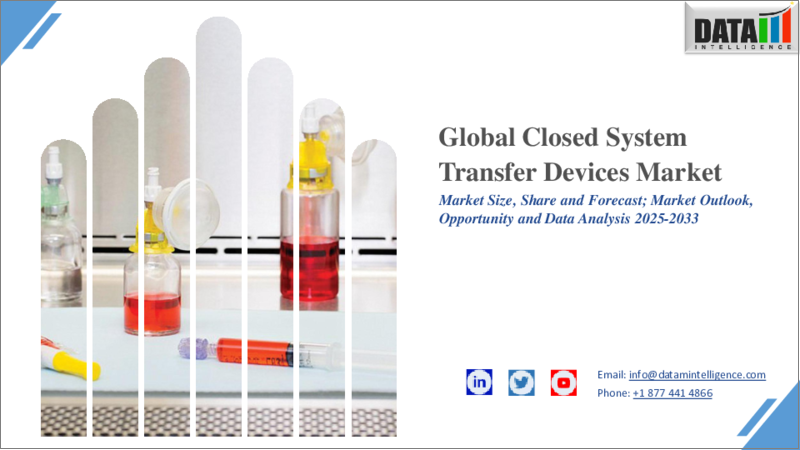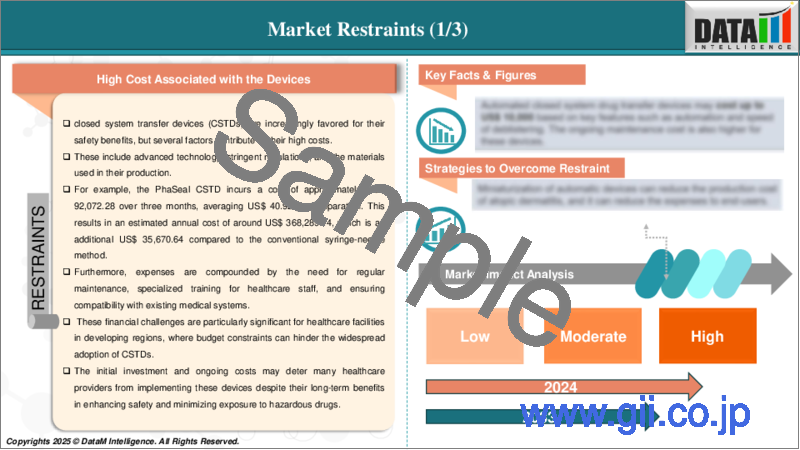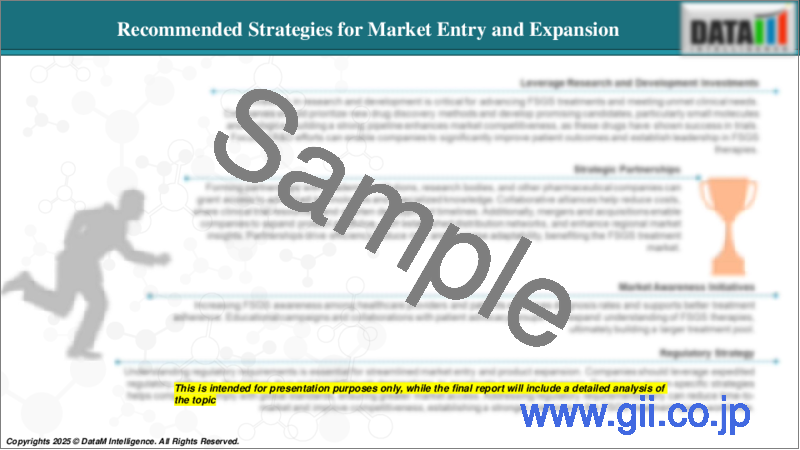|
|
市場調査レポート
商品コード
1654723
世界の閉鎖式薬物移送デバイス(CSTD)市場-2025-2033年Global Closed System Transfer Devices (CSTD) Market - 2025-2033 |
||||||
カスタマイズ可能
適宜更新あり
|
|||||||
| 世界の閉鎖式薬物移送デバイス(CSTD)市場-2025-2033年 |
|
出版日: 2025年02月13日
発行: DataM Intelligence
ページ情報: 英文 176 Pages
納期: 即日から翌営業日
|
- 全表示
- 概要
- 目次
世界の閉鎖式薬物移送デバイス(CSTD)市場は、2024年に7億1,829万米ドルに達し、2033年には19億6,826万米ドルに達すると予測され、予測期間2025年にはCAGR 11.7%で成長すると予測されています。
閉鎖式薬物移送デバイス(CSTD)は、外部からの汚染を防ぎ、有害物質や蒸気の流出を阻止しながら、危険な薬剤を安全に移送できるように設計された特殊な医療機器です。CSTDの主な機能は、医療従事者と患者の双方に深刻な健康問題(皮膚の炎症、生殖器の問題、がんなど)を引き起こす可能性のある危険薬物にさらされるリスクを大幅に低減する安全な環境を作り出すことです。閉鎖的なシステムを確立することで、CSTDはこれらの強力な薬剤の取り扱いに関わるすべての人の健康と安全を守るために不可欠です。
CSTDは通常、物理的バリアCSTDと空気清浄CSTDという2つの設計コンセプトのいずれかに従っています。物理的バリアCSTDは、薬剤の蒸気、エアロゾル、液体が環境に放出されるのを防ぐと同時に、汚染物質が無菌薬剤経路に侵入するのを阻止する機械的手段を採用しています。対照的に、空気清浄CSTDは、システム内の空気を清浄化して有害物質が漏れないようにする技術を利用しており、薬剤取り扱い時の安全性をさらに高めています。
市場力学:
促進要因と抑制要因
技術進歩の高まり
技術進歩の高まりは、閉鎖式薬物移送デバイス(CSTD)市場の成長を大きく促進すると予想されます。材料科学と設計の革新により、CSTDの効率性と耐久性が向上し、より使いやすく、危険な薬物曝露から個人を保護する効果が高まっています。機能的な流体経路、直感的なロック機構、さまざまな薬剤容器やデリバリーシステムとの互換性の向上といった主な特徴が、ヘルスケア現場での採用拡大に寄与しています。これらの進歩は、安全性を高めるだけでなく、危険な薬剤の取り扱いと投与を合理化し、医療環境における効果的な安全対策への需要の高まりに対応しています。例えば、2024年12月、Zephyrus Innovations社は、マサチューセッツ州ボストンで開催されたPartnership Opportunities in Drug Delivery会議で、最新製品である世界初の注射可能な閉鎖式薬物移送デバイスをVaporShieldを発表しました。
しかし、研究開発は、より高効率でより安価なソリューションの開発に向け続けられており、これがCSTD市場の将来の技術に向けた重要な原動力であり続けると予想されます。
デバイスに関連する高コスト
閉鎖式薬物移送デバイス(CSTD)は、その安全性の高さからますます支持されるようになってきていますが、いくつかの要因が高コストの要因となっています。先進技術、厳しい規制、製造に使用される材料などです。例えば、PhaSeal CSTDの場合、3カ月間で約92,072.28米国ドル(1製剤あたり平均40.92米ドル)のコストがかかります。この結果、年間推定コストは約368,289.14米ドルとなり、従来のシリンジ・ニードル法と比べて35,670.64米ドルの追加となります。
さらに、定期的なメンテナンス、ヘルスケアスタッフに対する専門的なトレーニング、既存の医療システムとの互換性の確保などが必要となり、費用はさらにかさみます。こうした経済的課題は、予算の制約がCSTDの普及を妨げる開発途上地域のヘルスケア施設にとって特に重大です。初期投資と継続的なコストは、安全性を高め、危険薬物への曝露を最小限に抑えるという長期的な利点があるにもかかわらず、多くのヘルスケア提供者がこれらの装置の導入を躊躇する可能性があります。
目次
第1章 調査手法と調査範囲
第2章 定義と概要
第3章 エグゼクティブサマリー
第4章 市場力学
- 影響要因
- 促進要因
- 技術進歩の高まり
- 抑制要因
- デバイスに関連する高コスト
- 機会
- 影響分析
- 促進要因
第5章 産業分析
- ポーターのファイブフォース分析
- サプライチェーン分析
- 価格分析
- 特許分析
- 規制分析
- SWOT分析
- アンメットニーズ
第6章 製品タイプ別
- 膜対膜システム
- ニードルレスシステム
第7章 コンポーネント別
- バイアルアクセスデバイス
- 注射器安全装置
- バッグスパイク
- オスとメスのルアーコンポーネント
第8章 閉鎖機構別
- クリックロックシステム
- ルアーロックシステム
- プッシュ・トゥ・ターン
- カラーツーカラーシステム
第9章 技術別
- 横隔膜ベースのデバイス
- 空気ろ過装置
第10章 最終用途別
- 病院
- クリニック
- その他
第11章 地域別
- 北米
- 米国
- カナダ
- メキシコ
- 欧州
- ドイツ
- 英国
- フランス
- スペイン
- イタリア
- その他欧州地域
- 南米
- ブラジル
- アルゼンチン
- その他南米
- アジア太平洋地域
- 中国
- インド
- 日本
- 韓国
- その他アジア太平洋地域
- 中東・アフリカ
第12章 競合情勢
- 競合シナリオ
- 市況・シェア分析
- M&A分析
第13章 企業プロファイル
- Becton, Dickinson and Company
- 会社概要
- 製品ポートフォリオ
- 製品説明
- 製品の主要業績評価指標(KPI)
- 過去および予測の製品販売
- 製品販売量
- 財務概要
- 会社の収益
- 地域別収益分配
- 収益予測
- 主な発展
- 合併と買収
- 主な製品開発活動
- 規制当局の承認等
- SWOT分析
- ICU Medical, Inc.
- EQUASHIELD
- B. Braun SE
- Yukon Medical
- Simplivia Healthcare, LLC
- JMS Co.Ltd.
- West Pharmaceutical Services, Inc
- Cormed.
- Epic Medical
- Similar data will be provided for each market player.
第14章 付録
The global Closed System Transfer Devices (CSTD) market reached US$ 718.29 million in 2024 and is expected to reach US$ 1968.26 million by 2033, growing at a CAGR of 11.7% during the forecast period 2025-2033.
A closed system drug transfer device (CSTD) is a specialized medical device engineered to facilitate the safe transfer of hazardous drugs while preventing contamination from external sources and blocking the escape of hazardous substances or vapors. The primary function of CSTDs is to create a secure environment that significantly reduces the risk of exposure to dangerous drugs, which can lead to serious health issues for both healthcare professionals and patients, including skin irritations, reproductive problems, and even cancer. By establishing a closed system, CSTDs are vital in protecting the health and safety of everyone involved in handling these potent medications.
CSTDs typically follow one of two design concepts: physical barrier CSTDs and air-cleaning CSTDs. Physical barrier CSTDs employ mechanical means to prevent the release of drug vapors, aerosols, and liquids into the environment while also blocking contaminants from entering the sterile drug pathway. In contrast, air-cleaning CSTDs utilize technologies that clean the air within the system to ensure that hazardous substances do not escape, further enhancing safety during drug handling.
Market Dynamics: Drivers & Restraints
Rise in the Technological Advancements
Rising technological advancements are anticipated to significantly propel the growth of the closed-system drug transfer device (CSTD) market. Innovations in material science and design have enhanced the efficiency and durability of CSTDs, making them more user-friendly and effective in protecting individuals from hazardous drug exposure. Key features such as functional fluid pathways, intuitive locking mechanisms, and improved compatibility with various drug containers and delivery systems have contributed to their increased adoption in healthcare settings. These advancements not only enhance safety but also streamline the handling and administration of hazardous drugs, addressing the growing demand for effective safety measures in medical environments. For instance, in December 2024, Zephyrus Innovations unveiled its latest product, VaporShield, the world's first injectable closed system transfer device, at the Partnership Opportunities in Drug Delivery conference in Boston, MA.
However, research and development will keep being geared towards developing cheaper solutions with higher efficiency, and this is expected to remain a key driving force toward the future of technology in the CSTD market.
High Cost Associated with the Devices
Closed System Drug Transfer Devices (CSTDs) are increasingly favored for their safety benefits, but several factors contribute to their high costs. These include advanced technology, stringent regulations, and the materials used in their production. For example, the PhaSeal CSTD incurs a cost of approximately US$ 92,072.28 over three months, averaging US$ 40.92 per preparation. This results in an estimated annual cost of around US$ 368,289.14, which is an additional US$ 35,670.64 compared to the conventional syringe-needle method.
Furthermore, expenses are compounded by the need for regular maintenance, specialized training for healthcare staff, and ensuring compatibility with existing medical systems. These financial challenges are particularly significant for healthcare facilities in developing regions, where budget constraints can hinder the widespread adoption of CSTDs. The initial investment and ongoing costs may deter many healthcare providers from implementing these devices despite their long-term benefits in enhancing safety and minimizing exposure to hazardous drugs.
Segment Analysis
The global closed system transfer devices (CSTD) market is segmented based on product type, component, closing mechanism, technology, end user, and region.
Product Type:
Membrane-to-membrane closed systems segment is expected to dominate the global closed system transfer devices (CSTD) market share
Membrane-to-membrane closed systems for drug transfer function similarly to closed system drug transfer devices (CSTDs), utilizing a membrane seal to facilitate the transfer of hazardous drugs between containers while safeguarding the environment from contaminants. The growth of the membrane-to-membrane systems segment is driven by several factors, including significant product launches, heightened promotion of established CSTD devices for chronic disease management, and the increasing use of safety devices within this segment.
These membrane-to-membrane needle pathway CSTDs employ two adjacent membranes engaged by needles to facilitate drug removal and pressure equalization. When disengaged, the needles are scrubbed of any drug residue by the membranes, ensuring secure storage within the system. Recent studies indicate that systems like the Equashield II effectively minimize leakage and spills during drug compounding. This underscores the importance of carefully selecting CSTDs based on their design and functionality to enhance safety outcomes in healthcare settings.
Geographical Analysis
North America is expected to hold a significant position in the global closed system transfer devices (CSTD) market share
North America is projected to hold a significant share of the closed system drug transfer devices (CSTD) market, driven by several key factors. The region benefits from high technology adoption and a well-developed healthcare infrastructure, which are expected to sustain strong demand for safe and effective drug delivery systems in the near future. Regulatory bodies such as the U.S. FDA and EU impose stringent requirements for CSTDs, further promoting market growth. Additionally, the increasing prevalence of cancer and the rising use of hazardous drugs in chemotherapy have heightened the need for these devices.
Product launches by various companies and government initiatives supporting the use of closed systems will also contribute significantly to market expansion. Awareness campaigns focusing on occupational safety for healthcare personnel underscore the importance of CSTDs in protecting workers from hazardous drug exposure. As a result, the North American CSTD market is poised for robust growth, reflecting both the urgency of addressing safety concerns and the commitment to advancing healthcare practices. For instance, in September 2023, EQUASHIELD has been recognized as the most used device for hazardous drug preparation and administration for five consecutive years by Pharmacy Purchasing & Products magazine. This remarkable achievement underscores EQUASHIELD's dedication to enhancing safety and efficiency in healthcare settings.
Similarly, in December 2023, West Pharmaceutical Services, Inc. a global leader in innovative solutions for injectable drug administration systems, announced FDA 510(k) clearance and launch of its Vial2Bag Advanced 13mm admixture device.
Competitive Landscape
The major global players in the closed system transfer devices (CSTD) market include Becton, Dickinson and Company, ICU Medical, Inc., EQUASHIELD, B. Braun SE, Yukon Medical, Simplivia Healthcare, LLC, JMS Co.Ltd., West Pharmaceutical Services, Inc, Cormed., and Epic Medical among others.
Key Developments
- In December 2024, Zephyrus Innovations VaporShield, the world's first injectable closed system transfer device, at the Partnership Opportunities in Drug Delivery conference in Boston, MA.
- In February 2024, Zephyrus Innovations received its first product 510(k) Marketing Clearance from the US FDA for its Aeroject 3ml safety syringe
Why Purchase the Report?
- Pipeline & Innovations: Reviews ongoing clinical trials, and product pipelines, and forecasts upcoming advancements in medical devices and pharmaceuticals.
- Product Performance & Market Positioning: Analyzes product performance, market positioning, and growth potential to optimize strategies.
- Real-World Evidence: Integrates patient feedback and data into product development for improved outcomes.
- Physician Preferences & Health System Impact: Examines healthcare provider behaviors and the impact of health system mergers on adoption strategies.
- Market Updates & Industry Changes: Covers recent regulatory changes, new policies, and emerging technologies.
- Competitive Strategies: Analyzes competitor strategies, market share, and emerging players.
- Pricing & Market Access: Reviews pricing models, reimbursement trends, and market access strategies.
- Market Entry & Expansion: Identifies optimal strategies for entering new markets and partnerships.
- Regional Growth & Investment: Highlights high-growth regions and investment opportunities.
- Supply Chain Optimization: Assesses supply chain risks and distribution strategies for efficient product delivery.
- Sustainability & Regulatory Impact: Focuses on eco-friendly practices and evolving regulations in healthcare.
- Post-market Surveillance: Uses post-market data to enhance product safety and access.
- Pharmacoeconomics & Value-Based Pricing: Analyzes the shift to value-based pricing and data-driven decision-making in R&D.
The Global Closed System Transfer Devices (CSTD) Market report delivers a detailed analysis with 60+ key tables, more than 50 visually impactful figures, and 176 pages of expert insights, providing a complete view of the market landscape.
Target Audience 2023
- Manufacturers: Pharmaceutical, Medical Device, Biotech Companies, Contract Manufacturers, Distributors, Hospitals.
- Regulatory & Policy: Compliance Officers, Government, Health Economists, Market Access Specialists.
- Technology & Innovation: AI/Robotics Providers, R&D Professionals, Clinical Trial Managers, Pharmacovigilance Experts.
- Investors: Healthcare Investors, Venture Fund Investors, Pharma Marketing & Sales.
- Consulting & Advisory: Healthcare Consultants, Industry Associations, Analysts.
- Supply Chain: Distribution and Supply Chain Managers.
- Consumers & Advocacy: Patients, Advocacy Groups, Insurance Companies.
- Academic & Research: Academic Institutions.
Table of Contents
1. Methodology and Scope
- 1.1. Research Methodology
- 1.2. Research Objective and Scope of the Report
2. Definition and Overview
3. Executive Summary
- 3.1. Snippet by Product Type
- 3.2. Snippet by Component
- 3.3. Snippet by Closing Mechanism
- 3.4. Snippet by Technology
- 3.5. Snippet by End-User
- 3.6. Snippet by Region
4. Dynamics
- 4.1. Impacting Factors
- 4.1.1. Drivers
- 4.1.1.1. Rise in the Technological Advancements
- 4.1.2. Restraints
- 4.1.2.1. High Cost Associated with the Devices
- 4.1.3. Opportunity
- 4.1.4. Impact Analysis
- 4.1.1. Drivers
5. Industry Analysis
- 5.1. Porter's Five Force Analysis
- 5.2. Supply Chain Analysis
- 5.3. Pricing Analysis
- 5.4. Patent Analysis
- 5.5. Regulatory Analysis
- 5.6. SWOT Analysis
- 5.7. Unmet Needs
6. By Product Type
- 6.1. Introduction
- 6.1.1. Analysis and Y-o-Y Growth Analysis (%), By Product Type
- 6.1.2. Market Attractiveness Index, By Product Type
- 6.2. Membrane-to-Membrane Systems*
- 6.2.1. Introduction
- 6.2.2. Market Size Analysis and Y-o-Y Growth Analysis (%)
- 6.3. Needleless Systems
7. By Component
- 7.1. Introduction
- 7.1.1. Market Size Analysis and Y-o-Y Growth Analysis (%), By Component
- 7.1.2. Market Attractiveness Index, By Component
- 7.2. Vial Access Devices*
- 7.2.1. Introduction
- 7.2.2. Market Size Analysis and Y-o-Y Growth Analysis (%)
- 7.3. Syringe Safety Devices
- 7.4. Bag Spikes
- 7.5. Male and Female Luer Components
8. By Closing Mechanism
- 8.1. Introduction
- 8.1.1. Market Size Analysis and Y-o-Y Growth Analysis (%), By Closing Mechanism
- 8.1.2. Market Attractiveness Index, By Closing Mechanism
- 8.2. Click-to-Lock Systems*
- 8.2.1. Introduction
- 8.2.2. Market Size Analysis and Y-o-Y Growth Analysis (%)
- 8.3. Luer-Lock Systems
- 8.4. Push-to-Turn
- 8.5. Color-to-Color Systems
9. By Technology
- 9.1. Introduction
- 9.1.1. Market Size Analysis and Y-o-Y Growth Analysis (%), By Technology
- 9.1.2. Market Attractiveness Index, By Technology
- 9.2. Diaphragm-Based Devices*
- 9.2.1. Introduction
- 9.2.2. Market Size Analysis and Y-o-Y Growth Analysis (%)
- 9.3. Air Filtration Devices
10. By End-User
- 10.1. Introduction
- 10.1.1. Market Size Analysis and Y-o-Y Growth Analysis (%), By End-User
- 10.1.2. Market Attractiveness Index, By End-User
- 10.2. Hospitals*
- 10.2.1. Introduction
- 10.2.2. Market Size Analysis and Y-o-Y Growth Analysis (%)
- 10.3. Clinics
- 10.4. Others
11. By Region
- 11.1. Introduction
- 11.1.1. Market Size Analysis and Y-o-Y Growth Analysis (%), By Region
- 11.1.2. Market Attractiveness Index, By Region
- 11.2. North America
- 11.2.1. Introduction
- 11.2.2. Key Region-Specific Dynamics
- 11.2.3. Market Size Analysis and Y-o-Y Growth Analysis (%), By Product Type
- 11.2.4. Market Size Analysis and Y-o-Y Growth Analysis (%), By Component
- 11.2.5. Market Size Analysis and Y-o-Y Growth Analysis (%), By Closing Mechanism
- 11.2.6. Market Size Analysis and Y-o-Y Growth Analysis (%), By Technology
- 11.2.7. Market Size Analysis and Y-o-Y Growth Analysis (%), By End-User
- 11.2.8. Market Size Analysis and Y-o-Y Growth Analysis (%), By Country
- 11.2.8.1. U.S.
- 11.2.8.2. Canada
- 11.2.8.3. Mexico
- 11.3. Europe
- 11.3.1. Introduction
- 11.3.2. Key Region-Specific Dynamics
- 11.3.3. Market Size Analysis and Y-o-Y Growth Analysis (%), By Product Type
- 11.3.4. Market Size Analysis and Y-o-Y Growth Analysis (%), By Component
- 11.3.5. Market Size Analysis and Y-o-Y Growth Analysis (%), By Closing Mechanism
- 11.3.6. Market Size Analysis and Y-o-Y Growth Analysis (%), By Technology
- 11.3.7. Market Size Analysis and Y-o-Y Growth Analysis (%), By End-User
- 11.3.8. Market Size Analysis and Y-o-Y Growth Analysis (%), By Country
- 11.3.8.1. Germany
- 11.3.8.2. U.K.
- 11.3.8.3. France
- 11.3.8.4. Spain
- 11.3.8.5. Italy
- 11.3.8.6. Rest of Europe
- 11.4. South America
- 11.4.1. Introduction
- 11.4.2. Key Region-Specific Dynamics
- 11.4.3. Market Size Analysis and Y-o-Y Growth Analysis (%), By Product Type
- 11.4.4. Market Size Analysis and Y-o-Y Growth Analysis (%), By Component
- 11.4.5. Market Size Analysis and Y-o-Y Growth Analysis (%), By Closing Mechanism
- 11.4.6. Market Size Analysis and Y-o-Y Growth Analysis (%), By Technology
- 11.4.7. Market Size Analysis and Y-o-Y Growth Analysis (%), By End-User
- 11.4.8. Market Size Analysis and Y-o-Y Growth Analysis (%), By Country
- 11.4.8.1. Brazil
- 11.4.8.2. Argentina
- 11.4.8.3. Rest of South America
- 11.5. Asia-Pacific
- 11.5.1. Introduction
- 11.5.2. Key Region-Specific Dynamics
- 11.5.3. Market Size Analysis and Y-o-Y Growth Analysis (%), By Product Type
- 11.5.4. Market Size Analysis and Y-o-Y Growth Analysis (%), By Component
- 11.5.5. Market Size Analysis and Y-o-Y Growth Analysis (%), By Closing Mechanism
- 11.5.6. Market Size Analysis and Y-o-Y Growth Analysis (%), By Technology
- 11.5.7. Market Size Analysis and Y-o-Y Growth Analysis (%), By End-User
- 11.5.8. Market Size Analysis and Y-o-Y Growth Analysis (%), By Country
- 11.5.8.1. China
- 11.5.8.2. India
- 11.5.8.3. Japan
- 11.5.8.4. South Korea
- 11.5.8.5. Rest of Asia-Pacific
- 11.6. Middle East and Africa
- 11.6.1. Introduction
- 11.6.2. Key Region-Specific Dynamics
- 11.6.3. Market Size Analysis and Y-o-Y Growth Analysis (%), By Product Type
- 11.6.4. Market Size Analysis and Y-o-Y Growth Analysis (%), By Component
- 11.6.5. Market Size Analysis and Y-o-Y Growth Analysis (%), By Closing Mechanism
- 11.6.6. Market Size Analysis and Y-o-Y Growth Analysis (%), By Technology
- 11.6.7. Market Size Analysis and Y-o-Y Growth Analysis (%), By End-User
12. Competitive Landscape
- 12.1. Competitive Scenario
- 12.2. Market Positioning/Share Analysis
- 12.3. Mergers and Acquisitions Analysis
13. Company Profiles
Key Market Players
- 13.1. Becton, Dickinson and Company*
- 13.1.1. Company Overview
- 13.1.2. Product Portfolio
- 13.1.2.1. Product Description
- 13.1.2.2. Product Key Performance Indicators (KPIs)
- 13.1.2.3. Historic and Forecasted Product Sales
- 13.1.2.4. Product Sales Volume
- 13.1.3. Financial Overview
- 13.1.3.1. Company Revenue's
- 13.1.3.2. Geographical Revenue Shares
- 13.1.3.3. Revenue Forecasts
- 13.1.4. Key Developments
- 13.1.4.1. Mergers & Acquisitions
- 13.1.4.2. Key Product Development Activities
- 13.1.4.3. Regulatory Approvals etc.
- 13.1.5. SWOT Analysis
- 13.2. ICU Medical, Inc.
- 13.3. EQUASHIELD
- 13.4. B. Braun SE
- 13.5. Yukon Medical
- 13.6. Simplivia Healthcare, LLC
- 13.7. JMS Co.Ltd.
- 13.8. West Pharmaceutical Services, Inc
- 13.9. Cormed.
- 13.10. Epic Medical
- Similar data will be provided for each market player.
LIST NOT EXHAUSTIVE
14. Appendix
- 14.1. About Us and Services
- 14.2. Contact Us






